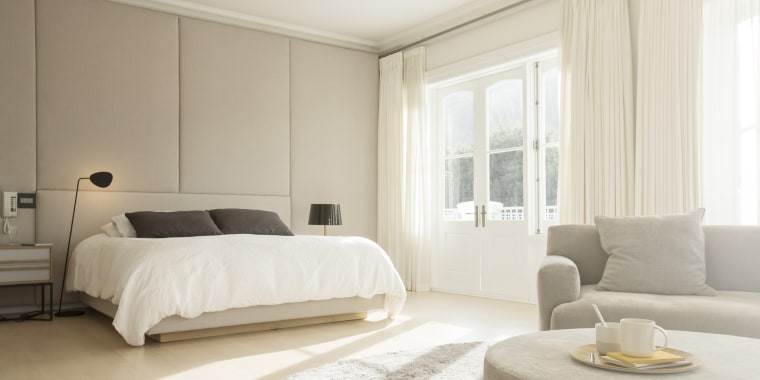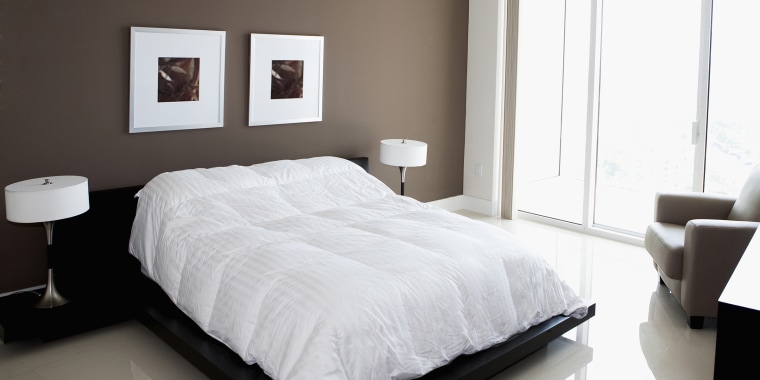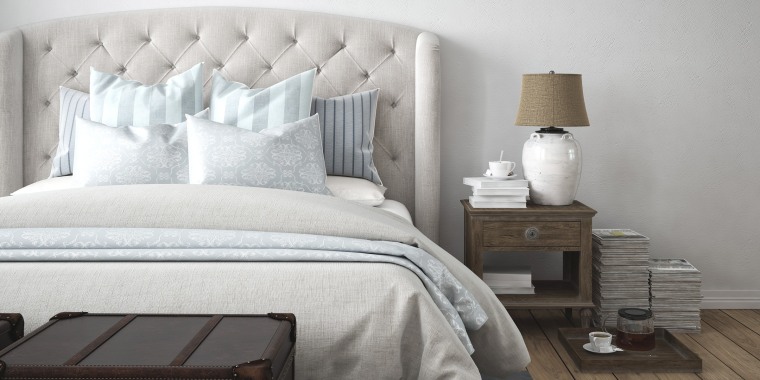The simplest questions sometimes can be the hardest ones to answer. “Where should I position my bed?” is a case in point. The answers can be many and contradictory, and the deeper you dig, the more you discover. Let’s explore the common solutions and find out the thinking behind them.
1. People say: You have to position the head of the bed against the main wall.
But actually: This is not always the best solution, as it depends on the layout of the bedroom and the adjoining rooms.
Feng shui — which considers spatial relationships in relation to the flow of life energy, or chi — usually would come out strongly in favor of pushing the bed up against the main wall of a bedroom. But it warns against doing so if there are bathroom drainage pipes or gas pipes running through the wall. Even those who don’t believe in chi might chime in here to agree, because, while a bed next to the plumbing might not flush your success away, you don’t want gurgling pipes interfering with your sleep.
Interior designers will tell you that the positioning of the bed depends on the size and proportions of the bedroom. “If the floor plan is square, then it’s best to place the bed on the central axis,” Russian designer Julia Golavskaya says. “But what if the bedroom is a rectangle? Then it’s best to divide the room into zones, with the bed located in one zone and a chair and table in the other, for example.”
If you’ve lucked out and have a large and harmoniously proportioned bedroom to work with, designers advise placing the bed so it’s free-standing. This kind of “island” layout can help combat a feeling of emptiness and shortage of furniture in huge spaces. But this design isn’t always best — it would look odd to locate a bed 25 feet from the window in a gigantic room.
That’s interesting: An informal poll that put the question of bed location to Houzz users worldwide found that positioning the headboard against the main wall was the most popular choice.
About three-quarters of poll takers favored this option in the UK, Russia, the U.S., Switzerland, Denmark, Australia, New Zealand and Singapore. About two-thirds preferred it in Spain, Italy, Germany and Japan. About half of French voters supported this layout.
Get more Everyday Solutions right in your inbox by signing up for the newsletter here.
2. People say: You should have a good view of the bedroom door from your bed.
But actually: It’s also nice if the entire bed isn’t visible from outside the open door.
Humans have the same primal needs as mammals in wanting to sleep in a secure location. This subconsciously drives us toward practical choices, such as wanting a safe distance from “unsafe” objects, such as doors and windows, and having good visibility of any intruder without allowing the intruder to see us first, according to a 2010 study by Matthias Spörrle and Jennifer Stich of the University of Munich in Germany.
“From a psychological viewpoint, it’s important to keep the bed as far as possible from the door while still making sure the door can be seen from the sleeping position. However, if there’s a window in the room, then you should be able to see both the door and the window at once from your bed,” Russian psychologist Natalya Mikhailova says of the study results.
“I find it interesting that most of the respondents in the study expressed a preference for locating the bed against the same wall in which the door is located, as it makes sleepers less visible to potential intruders,” Mikhailova says.
“Another benefit of that layout is that light shining through an open door won’t wake up anyone sleeping,” says Stepan Bugaev, artistic director of Pobeda Dizaina (Victory of Design).
That’s interesting: Among Houzz users, a bed located against a wall with a door was the second-most popular choice. Fourteen to 15 percent of users voted for it in the informal Houzz polls, with French users (17 percent) favoring it the most.

3. People say: You shouldn’t sleep with your legs facing the door.
But actually: This may not be true for all doors, such as the door to a dressing room.
There are many cultural reasons why in some regions it’s considered bad to sleep with your feet toward a door. One example is from Islamic tradition: “When you’re in the sleeping position, you don’t have your legs facing directly towards the door into the bedroom. [This is out of] politeness, because facing the soles of your feet towards someone, especially elders, is considered rude,” says Amilia Gani, an interior designer from Singapore.
In Russia, another country with strongly held domestic superstitions, nobody would sleep with their legs facing the door, even if it’s the only logical place for the bed. Say you have a narrow bedroom in which the window is opposite the door: Russians would place the bed crosswise. They do this because of the custom of carrying a coffin out of a residence with the feet going through the door first. Nobody wants that kind of association in their bedroom.
Not sleeping with your feet toward the door is fundamental in feng shui too, along with other don’ts, such as putting a mirror opposite the bed or sleeping under a chandelier or ceiling beams, or between two doors.
But not everyone worries about sleeping with their legs toward the doorway. U.S. user JudyG Designs commented on the Houzz poll: “I like to enter the room and see the foot of the bed first.” Dozens of users gave her comment a thumbs-up.
Sometimes positioning is simply a case of pragmatism. In this studio space, for instance, the sleep zone is open to the main living space. And the only place the bed can go is with the head against the window and the foot toward the door.
Regina Chen, the Singaporean designer of this project, says: “The existing apartment had two rooms. The owner preferred to have an en suite design where they can enjoy a larger space, like an executive hotel suite. That was the main reason for us to propose this layout. We tried various designs, such as changing the ways the bed and wardrobe face, but none of the layouts allowed maximum space as the selected scheme does.”
4. People say: You need to position the bed along a certain compass bearing.
But actually: There’s no compass bearing that people agree on — not even feng shui practitioners or geomagnetic consultants.
Japanese tradition says you can sleep pointing in any direction — except with your head facing north. “In Japan, kitamakura, which means to sleep with the head toward the north, is thought of as being a bad omen,” says Yuki Shimada, a feng shui consultant and interior designer. “Traditionally, we lay a deceased [person] with their head toward the north, so it reminds [us of] death.
“This is derived from the figure of Buddha [when he] died more than 2,500 years ago,” Shimada says. “However, in India, where Buddhism originated … there is no custom like this. More than that, recently it is said to be scientifically good for health, because of geomagnetic influences.”
However, feng shui doesn’t generalize about the right direction of a bed. As Olesya Runova, director of the St. Petersburg Feng Shui Center, says: “Each of us has our own Gua number, calculated from our birth year. With a person’s Gua number [also known as Kua number, Lo-shu number or Ming Gua] we can work out which compass bearings would work best for them — and which should be avoided. Knowing their Gua number enables people to use the Earth’s magnetic power to achieve their objectives, including financial success.”
According to this philosophy, the right compass bearing of a bed is individual. What happens, though, when couples have different Gua numbers? The answer in the past was to arrange the bed to suit the husband but also so that the wife didn’t suffer as a result. These days, however, when many women are the family’s main breadwinner, consultants suggest locating the bed’s direction so it suits whoever is bringing home the most income.
That’s interesting: Nearly half of voters in the Houzz poll in Russia said they placed the bed with its head facing north. The second-most popular choice among Houzz voters in Russia — at 25 percent — was east, along the Earth’s magnetic lines.
Interior designer Elina Shepeleva notes the results of a Russian physicians study, conducted in Ekaterinburg. The doctors studied the directions in which people most easily enjoyed sound sleep. “We offered the test participants a huge bed to sleep in, so they could face any direction they liked. It turned out that when people are severely tired, people fall asleep facing eastwards. But those who go to bed in an overexcited state place their heads facing north.”
5. People say: If you have a panoramic view from your window, you need to make use of this and place the bed so it looks toward the window.
But actually: This may be great if the window looks out onto woodland, but it’s not ideal if the window faces the sun.
If the bedroom window faces the morning sun, placing the bed close to it might cause discomfort. Either that or the window will stay curtained, and the whole idea of gazing out at beautiful sunrises is lost.
“Region is the deciding factor here. If you’re located nearer to the equator, the angle of the setting sun is around 90 degrees. The headboard of the bed, especially if it’s low, won’t shelter your sleeping head from the sunlight, and you’ll get too hot,” Russian architect Mikhail Altotskiy says. “But let’s look at homes in northern climes, where temperatures are low but winds can be high. This can all play hell with the durable operational life of your windows. Synthetic window seals don’t last forever and will eventually let the drafts in.
“Another point is that compared to walls, windows are a major source of heat loss in your home,” Altotskiy says. “The bedroom air near the windows is colder and more prone to air movement, and this can cause dehydration of your mucous tract. The optimal solution in those conditions is to either install heated glass or even consider changing the layout.”
Are you plagued by sleeplessness? Then facing toward a window or TV is a real no-no. “Our bedroom needs to be a sanctuary for sleep, so only those things related to sleep should be in there. That means no computers, TVs or other gadgets. Your bedroom is the sleep room, not a cinema,” says Dr. Neil Stanley, an independent sleep expert in the UK.
Sleep consultant Dr. Mikhail Poluektov, dean of the Department of Sleep Medicine at University Clinical Hospital No. 3 in Moscow, is absolutely firm about this. “There shouldn’t be any mental or intellectual activity at all once you go to bed. We don’t recommend reading or watching television in bed. This means that if your small bedroom has a window on one wall and a door on another, and you’re thinking of mounting a television on the only wall that doesn’t have cupboards arranged along it — then it’s time to think again.”

6. People say: The right location for your bed is the one in which you feel most comfortable.
And actually: This is probably the right answer.
A designer’s intuition may win out over feng shui theory or the rules of architecture. “Whenever I visit anywhere new, I always aim to find the most attractive spot with the highest energy levels. I simply sense what’s going to be the best location for the bed — and that’s it!” says interior designer Irina Kovylina.
Designer Elena Savchenko shares a personal experience. “I recently had an unwanted situation in my life and wanted to make a few minor changes that would improve my life. As a result, we moved the location of the bed. I turned it around 90 degrees and moved the head off the wall so as to keep it out of an area where a bundle of problems had been forecast. But the electric sockets, switches, fitted lighting and a beautiful large decorative panel were all left stranded on a different wall, where they’d originally been planned in the layout. But you know what? I don’t regret it at all, because as a result, there was a huge change in my bedroom, and it became a charming place where I love spending time on the bed. So it’s true — magic can really happen. And I tell you this as an interior designer.”
This article was originally published on Nov. 4, 2016 on TODAY.com.
